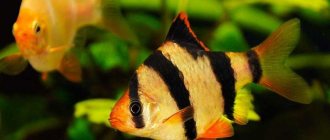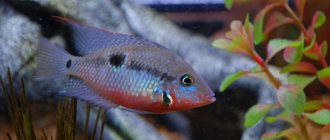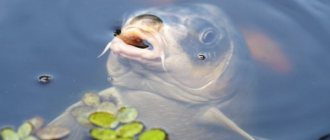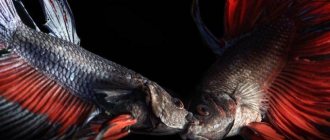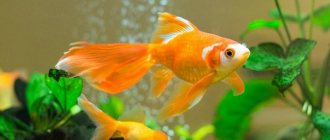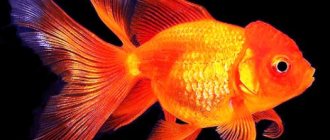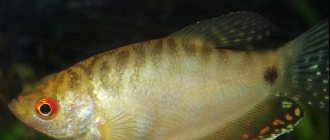To ensure a peaceful atmosphere in the aquarium, when selecting fish, it is necessary to take into account their compatibility. Otherwise, constant skirmishes and even the death of one or more fish are possible. When populating an aquarium, it is better to use the recommendations of specialists. For example, they assess the compatibility of gourami with other fish as high, but at the same time, their neighbors must be peaceful.
Neighbors for these fish should be peaceful
History of the origin of gourami
The dream of the French scientist Pierre Carbonnier was to acclimatize the original tropical fish. And among them were gourami - fish with a wide forehead, which often rose to the surface and stuck the tips of their muzzles out of the water.
However, their journey from the tropics to Europe turned out to be long. They were caught in Thailand, Vietnam, and also on the Malaysian islands, but the individuals could not withstand transportation and died one by one within 24 hours.
At that time, exotic fish were transported by placing them in wooden barrels, which were filled to the top with water. While moving, the ship experienced rocking, and to prevent water from splashing out of the containers, and the fish flying out with them, wooden disks were placed in them, completely blocking the fish’s access to the surface.
At that time, few people understood the characteristics of fish with a labyrinthine organ, although Carbonnier had already managed to study and breed representatives of the macropod family. Without access to atmospheric air masses, the unfortunate “travelers” were doomed and died before the ship sailed.
After numerous unsuccessful attempts, the fish were classified as problematic, they lost interest, and their distribution stopped for a long period. People who saw how gourami were caught from terribly polluted bodies of water - sewers, barrels, abandoned quarries, were perplexed - how could they live in such conditions and die in barrels with much cleaner water?
Only towards the end of the 19th century did one quick-witted European understand what was going on. He watched these “capricious” creatures and noticed that they, no, no, would rise to the surface and stick their nose out of the water. On the recommendation of one of the Indonesian guides, he did not completely fill the transport containers with water and did not seal them. This brought a positive result - all the fish survived the trip.
Gouramis were introduced into aquariums by European amateur aquarists only in 1896, and into domestic aquariums a year later by the Berlin breeder Matte and V.M. Desnitsky, who brought individuals from Singapore.
Social structure and reproduction
Photo: Pair of gourami fish
Sexual maturity of gourami fish occurs at 8-12 months. As a rule, the female lays eggs 4-5 times at time intervals of 10-12 days, after which the breeding process is completed. The number of eggs is about 50-200 in a litter. Sexual dimorphism is clearly expressed in almost all representatives of the gourami genus. In addition to differences in the structure and shape of the fin (as mentioned above), during spawning the scales of males acquire a brighter color.
Only the male gourami takes part in creating the nest. The material for the nest is air and saliva - the fish uses it to glue air bubbles together. The simplest “technology” allows you to create a comfortable nest, the size of which reaches 5 cm and can accommodate all the offspring. As a rule, gourami spend no more than a day to solve the “housing issue”. After which the “head of the family” invites the female to spawn. The male captures the eggs with his mouth and places them in the nest, where their further development occurs.
Interesting fact: Some species of gourami spawn without creating a nest. In this case, the eggs simply float on the surface of the water. No matter how we feel, only the male takes care of the eggs.
Gourami larvae emerge from the eggs within a day or two. Newborn fish are very small in size, with a yolk sac that serves as their source of nutrition for the next 3-4 days. The next “dish” on the gourami menu are ciliates, zooplankton and other protozoa. But in artificial conditions, as soon as the fry leave the nest, the male gourami must be immediately removed from the aquarium: an overly caring father can easily harm the babies while trying to return them back to the nest.
The labyrinthine organ of newborn gourami is formed only 2-3 weeks after birth, so at first the babies will find it very helpful to have clean water with good aeration. It is very important to promptly remove excess food from the aquarium. In the right conditions, the fry grow very quickly, but unevenly, and therefore it is recommended to systematically sort the fish by size.
Habitat of gourami in the natural environment
In nature, these fish live in the Indo-Malayan zoogeographic region, characterized by incredible biodiversity.
- Pearl representatives of the species were discovered in the reservoirs of the largest archipelago in the world - the Malayan, more precisely on its large islands - Sumatra and Kalimantan.
- Lunar - live in Thai and Cambodian reservoirs.
- Serpentine - their habitat extends to southern Vietnam, Cambodia and eastern Thailand.
- Spotted gourami - distributed from India to the Malay Archipelago.
In different areas of this range there are different local forms of gourami, which are distinguished by color. For example, in Sumatra, in addition to the main forms, you can find blue gourami. The serpentine gourami, which prefers to live in the waters of the ocean coast off Sri Lanka, never appeared on the lowlands of the island itself, but successfully took root in the Caribbean and appeared in the waters of the North American continent.
These creatures can be found in both stagnant and flowing waters. In addition, they feel good in small streams and large rivers. And the spotted gourami managed to master the ebb-tidal zone and estuarine waters, consisting of sea and fresh water.
What they look like
They are characterized by the same body structure. Subspecies can differ from each other in size, color, life expectancy and smaller features.
Gourami looks like a slender, laterally dense fish. The long anterior pelvic fins perform a tactile function. The body has an oblong, but at the same time not very elongated shape. Many gourami are distinguished by their brightly colored bodies, the most beautiful ones worth noting are pearl and honey. The description of gourami habitats is similar for all varieties; these are rivers and streams, poorly saturated with oxygen. Due to living in poor-quality water with little oxygen, they developed an epibranchial organ and a labyrinthine apparatus. Thanks to this, they can do without air for a long time.
Features of gourami
Gourami, or otherwise called "thread-bearing gouramis", are freshwater labyrinth fish from the tropics that belong to the macropod family. On average, the size of aquarium specimens ranges from 5 to 12 cm, but there are also larger representatives, reaching 20-25 cm in length (the largest are serpentine gouramis). However, the length of even those individuals that grow to impressive sizes in nature does not exceed 10 cm in an aquarium.
The name of the fish is associated with their feature - elongated thread-like fins on the abdomen, which they received for specific purposes - orientation in natural reservoirs with muddy water. Like other labyrinth fish, gourami have a labyrinth - an organ above the gills, which was formed as a result of the adaptation of individuals to living in waters with low oxygen levels.
Thread carriers have a unique ability to stay out of the aquatic environment for a long time - up to 6-8 hours. However, aquarists are not recommended to conduct such harsh experiments on their charges! The labyrinth is located in the epibranchial cavity, in the expansion of the first gill arch. There are several thin plates of bone tissue, abundantly penetrated with vessels and covered with mucous membranes.
If gourami can live without water, then without atmospheric air they will die. Being in a closed container, the fish literally suffocate. The development of the labyrinth organ occurs only 14-21 days after the larva hatches from the egg, so gourami fry need water saturated with oxygen.
There is a theory that the labyrinth helps the fish move from one aquatic environment to another: in this organ it contains a supply of water and before the individual reaches the next body of water, the gills are moistened and protected from drying out. When transporting gourami, and this applies to fish of all types, it is forbidden to pump oxygen into the container, as the fish will begin to grab it with its mouth, get a burn to the respiratory system and die.
Plants
Keeping and caring for this type of fish includes the creation of safe shelters. This is especially important if there are several males living in the aquarium. Weaker individuals must have room to hide.
Driftwood or grottoes are best suited for this purpose. You can also plant thickets of living plants. Driftwood must be of natural origin. Such objects release substances beneficial to fish into the water. The result is an aquarium environment that is as close to natural as possible.
Green plants are necessary for the normal functioning of gourami.
In an aquarium, plants should be planted in groups. It is necessary to create dense thickets to create shelters so that the males can build bubble nests in them.
It is also necessary to place several groups of floating plants. It is best to use Riccia or Pistia. But plant leaves should not be allowed to completely cover the surface of the water . Gourami need to periodically float up and swallow air.
The fish will feel most relaxed if the amount of vegetation in the aquarium reaches 50-80% of the area. Also, this species prefers a very slow current or its complete absence.
Under natural conditions, gourami live in small bodies of water with a large amount of plants and organic matter that are in the process of decomposition. They have very strongly developed pelvic fins, which at first glance resemble whiskers or tentacles. This type of fish also has a characteristic feature - atmospheric breathing (labyrinth).
Gourami prefer water that is stagnant. There is no need to equip the aquarium with powerful aeration or frequently change the liquid. It is also worth laying dark-colored soil on the bottom of the aquarium, and placing the lighting device directly above the artificial pond.
In such conditions, labyrinths acquire a rich color, reach sizes of up to 11 cm and live from seven to ten years.
Appearance of fish
The fish have an elongated, laterally flattened body . In males, the dorsal and anal fins are long, slightly pointed, while in females they are shorter and rounded. The length of the fins on the abdomen is equal to the length of the entire fish; the fins resemble thin antennae. If the owner of the aquarium notices that the antennae of his charges have broken off, there is no need to worry - after a while they will grow again.
Males have a more impressive appearance, and all thanks to their brighter, more saturated color. But only healthy fish have a bright color - if it turns pale, there is cause for concern. Gourami do not tolerate cold weather very well and often catch colds, so you should carefully monitor the temperature in the aquarium.
Compatibility with each other
The minimum compatibility of males is a proven fact. Females are peaceful and never bully underwater inhabitants. Males often show aggression towards each other in an aquarium full of gourami, regardless of species and color. Natural rivalry forces them to engage in fights with relatives in order to protect territory and gain the favor of females.
Representatives of one species get along well in a large reservoir, which they divide into sections and live, with a sufficient number of females, without crossing the boundaries of the selected territory.
Main varieties of gourami
Today in aquariums you can see a wide variety of gouramis: pearl, blue, marbled, golden, kissing, moon, grunting and others. However, experts distinguish only four species of gourami belonging to the genus Trichogaster:
- pearl;
- lunar;
- white;
- brown.
Pearl gourami
A fish with a tall, elongated body covered with silver-violet scales. The pearl gourami is decorated with numerous pearlescent spots on the body and fins, similar to pearls. There is an uneven dark stripe along the body. The average size of these thread carriers is 11 cm.
Pearl gouramis are not the best travelers and do not tolerate transportation and transfers well. In addition, they adapt for a long time, remaining timid and pale in color. The natural environment of the “pearls” is the reservoirs of India and Indochina, the southern part of Malaysia and Thailand. They are best suited to conditions with warm, clean water and rich vegetation.
Moon gourami
Today in nature they can be found in Cambodian and Thai reservoirs rich in vegetation. They were brought to Europe in the 50s of the last century, and domestic aquarists became acquainted with these tropical fish only three decades later.
The body has a traditional gourami shape - elongated, with compressed sides. The color of moonfish is uniform - silver-bluish in tone. Males can be distinguished by their long and sharp dorsal fin; their filamentous fin is orange, while that of females is yellow. In addition, during the spawning period in males, the chest area acquires a reddish-orange hue. The length of aquarium representatives does not exceed 12 cm.
Brown gourami
The largest representative of the genus Trichogaterus. Even living in an aquarium, individuals reach 15 cm in length. In the natural environment there are fish of larger sizes. Brown gouramis have a modest coloration - their body is covered with silver-brown scales, there are dark spots that form a stripe along the body.
There are also transverse stripes that are more pronounced in the tail. Like most gouramis, brown gourami have males that are more extravagantly and brightly colored. Breeders have more than once taken brown gouramis as a basis, and this is how species of golden, lemon, and marbled fish appeared.
Spotted gourami
Representatives of this species amaze the imagination with their diversity; their color can vary greatly from blue, yellow and white. But the presence of such a morph may be the cause of confusion in the gradation of the Trichogaster genus.
Actually, there are many species of gourami that have nothing to do with the genus Trichogaster:
- kissing gourami from the Helostom family;
- honey gourami - a representative of the Coliza genus;
- grumbling gourami - belongs to the genus Trichopsis;
- chocolate – sferichthys.
But domestic aquarium enthusiasts do not go into too much detail, and all these fish are popularly called gouramis. In addition, the inhabitants of the underwater world are often subject to reclassification, and with the light hand of scientific minds, yesterday’s Trichogaster becomes Trichopodus - and, oddly enough, both options are in use and both are correct.
Variety of colors
Varieties of gourami are distinguished by colorful colors and poetic names: marbled gourami, kissing, grumbling, honey, brooding and many others. But if we take a scientifically strict approach, then 4 species directly belong to trichogaster gourami:
- pearl gourami – light silver with a lilac sparkle, strewn with light spots - “pearls”, yellowish back, bluish fins, along the midline the body is divided in half by a dark dotted stripe;
pearl gourami
- moon gourami – about 12 cm long, bluish color with a steely sheen and bright orange eyes, bright, very long orange or yellow breast threads;
- brown gourami – the largest, can reach 15-17 cm, brown-silver, with a stripe along the body in the form of black spots, with transverse stripes of a darker shade than the background;
- spotted gourami – the most colorful, due to crossing, various combinations of yellow, blue and white are possible, spots all over the body of various shapes, transverse and longitudinal stripes are barely visible.
Some color morphs of spotted gourami received their own names - blue, gold and others.
Hybrid gouramis and representatives of other families
If you delve deeper into the gradation and division of gourami subspecies, it becomes clear that this name is quite arbitrary and unites many species of fish from several families, or more precisely, 12 species from five genera. Moreover, researchers identify the genus Helostoma as an independent family.
If you approach the issue scrupulously, you can find out that there is only one gourami - the real one is a commercial fish that reaches 75 cm in length. Residents of the Sunda Islands consider it a rare delicacy. But aquarists are offered a lot of species of “gourami” - dwarf individuals that are not even included in the four main varieties.
Marbled gourami
A mutational subspecies of blue gourami, the representatives of which are quite large in size. Marbled gourami have an oval-shaped body, high, compressed sides, and have characteristic features - thread-like elongated fins and an expanded anal fin.
The main color of the fish is light gray; against this background there are specks of various shapes of dark gray color. The fins, except the pectoral ones, are dark gray in color and covered with yellow spots. The pectoral fins have no color and are transparent. The male has a narrower body, brighter colors and long, pointed dorsal and anal fins.
Golden gourami
The natural habitat of these fish is the ponds of the island of Sumatra with abundant vegetation. The body shape is classic for gourami, the color is golden yellow with an orange tint. There are two dark spots on the side, one in the middle, the other on the tail. There are bluish spots on the main background.
The golden gourami is a peace-loving, timid fish that does not like to get into a fight, but prefers to retreat into the thicket of saving thickets. She is quite accommodating - her neighbors can be both large and small fish. But males of this species are capable of conflicting with each other.
Gourami kissing
These original fish live naturally in Thailand, Kalimantan, Sumatra and Java. They were originally discovered in Indian and Indo-Chinese reservoirs. The fish got their name from the characteristic lip movements that the fish make when they eat, show aggression, and court potential brides/grooms.
The dorsal and anal fins are elongated, of medium height, they are greenish, less often yellowish. The color of kissing gourami is variable; there are gray-green, golden-pink, and yellow individuals. In addition, fish suffering from albinism often appear.
The kissing gourami is a calm, peaceful fish, a little shy. If you place it with non-aggressive brothers, they will get along well in the same aquarium. If the tank turns out to be cramped, they may conflict over territory; they do this funny, opening their mouths. Like other gouramis, these inhabitants need vegetation and various shelters - snags, grottoes, pipes, etc. It is advisable to cover the bottom with dark soil material.
Chocolate gourami
These thread-bearers can be found in Sumatra, Borneo and Malaysia. The fish have a body of a red-brown or chocolate hue, which has a slightly greenish tint. The body has several transverse stripes of varying lengths and widths; their color can vary from light yellow to white. The anal fin is more narrowed, with a yellow border.
Chocolate gouramis are tiny, as they are 4-5 cm long. The male has a straight lower jaw profile, and his head is more pointed than that of the female. The female, due to the fact that she is incubating eggs, has a rounded lower jaw. But there are no differences in color and long fins, like other gouramis, between chocolate females and males.
Gourami grumbling
These fish were so named for their ability to reproduce sounds reminiscent of grunts or frog croaks. Today they have inhabited bodies of water throughout almost the entire territory of Indochina, the Malaysian peninsula and Singapore. These are peaceful underwater inhabitants, cowardly and conflict-free, they are an excellent option for a community aquarium.
Experienced aquarists recommend keeping these fish in a flock of 6-8 pieces; this can be an equal number of males and females, or 1 female for 2 males. Grumpy gouramis like to hide and avoid bright light, so it is advisable to place floating vegetation on the surface that will scatter the rays. In addition, fish plants are used to build nesting sites.
Neighbors with good compatibility
When creating an aqua system, you need to consider who the gourami gets along with in the aquarium. The peace of the aquarist himself and his pets will depend on this. The compatibility of gourami with other fish largely depends on the volume of the aquarium and the amount of vegetation inside. The larger the container and the denser the thickets, the less will be the threat of constant skirmishes and quarrels.
Gourami love a wide variety of plants
For these fish, it is advisable to plant 60-80% of the entire area of the aquarium with plants and create a slight current using a special attachment on the filter. Small fish that live in the lower and middle layers of water are ideal for labyrinths as neighbors.
Here's who you can keep gourami with:
- minors;
- tetras;
- iris;
- neons;
- battles;
- swordtails;
- platies;
- zebrafish;
- catfish.
It is also permissible to add some types of barbs. Angelfish and some other small cichlids will also get along well with gouramis. The aquarium must have a lid or cover glass, since labyrinthine representatives can jump out of the water.
Who do gouramis get along with?
These are peaceful, calm creatures that get along well with their own kind, non-conflict and non-aggressive fish. You can put them in the aquarium with bots, laliuses, thorns, etc. Gourami will not eat eggs, fry, chase other inhabitants or harm them in any other way.
But the filamentous antennae of gourami can suffer from fast, hyperactive neighbors. Swordtails, barbs, and sharks really like to rush after them and, if possible, grab them. Also, a not very friendly company will be made from threadfish and discus fish, shrimp, and guppies. Conflicts may arise between them, or some will simply eat the others.
As for the characteristics of water, threadtails feel good in a soft, acidic environment, so that the pH and dH do not rise above 7. Therefore, lovers of hard water are not suitable; this group includes barbs and irises.
Males of this species can conflict with each other, but only if they lack a mate or territory. If they live in a spacious tank, with vegetation and shelters, then the gourami will have no reason for “family” fights.
Absolutely incompatible
Gourami cannot get along with large fish, predators and aggressive species that conflict with each other and other fish.
Neighborhood is completely excluded:
- cockerels;
- goldfish;
- koi carp;
- astronotuses;
- African and South American cichlids.
Giant Astronotus are completely incompatible with gouramis and other small varieties.
How to set up an aquarium for gourami
An ideal tank for threadworms should be well planted, as these are the conditions in which they live in nature. On the side and in the background you can place pinnate, elodea, cryptocoryne, hornwort, and Thai fern.
Don't forget about floating plants; their fish are used to build nests. Duckweed, richia, pistia, and salvinia can spread on the surface. But at the same time, they need space for free swimming and secluded places for shelter.
Diseases
Fish have good immunity, which decreases under unfavorable conditions. Gourami diseases are standard:
- Ichthyophthyriosis - infection caused by dirty equipment and decor;
- Fin rot – non-compliance with temperature conditions, introduction of sick fish;
- Aeromonosis – due to overcrowding;
- Hexamitosis is a parasitic infection that requires urgent treatment. It manifests itself in the restlessness of the fish, they experience itching and rub against the surface;
- Ichthyosporidiosis is a parasitic infection;
- Lymphocystis is a mild parasitic infection that does not require treatment;
- Ligulosis - due to low-quality food (daphnia).
Treatment is mainly with antibiotics (kostapur, baktopur). After treatment, restoration with good food is required.
Feeding gourami
Gourami are not gourmets and will eat whatever is offered to them. But you shouldn’t feed them everything; it is advisable to balance and diversify the diet of your charges. You can alternate dry and live food, giving bloodworms, tubifex, daphnia, etc. In nature, the menu of these fish often includes insects and larvae, as well as plant products.
The easiest way is to choose ready-made complex food - this is a good option for aquarium fish. It should be purchased in specialized stores, giving preference to the packaged product. If the owner wants to create a diet for the aquarium inhabitants himself, one should take into account the size, type of gourami, as well as age characteristics.
Nature has made sure that these creatures can survive without food for a long time, and they even endure a 2-week hunger strike.
Limited compatibility
It is difficult for phlegmatic fish to coexist with overly active individuals or fish that are much larger than them.
Barbs
Hyperactive and cocky, if there are few plants in the reservoir, they can pluck their neighbors’ tails and fins. They are not afraid to pester even individuals that are larger than them.
Guppy
Viviparous, nimble fish can get along with slow-moving species if they grow together from childhood. Gourami get used to the flickering flock of guppies and do not pay attention to them.
Loaches
They live on the bottom, but can pinch the tails and tear off the fins of the most phlegmatic individuals. Often they drive away aquarium inhabitants from food that has fallen to the bottom.
Discus
Very large neighbors for small fish. They can destroy all small species, mistaking them for live food.
Gourami content
Beginners should listen to the recommendations of more experienced aquarists; this will help them avoid the following common mistakes:
- These fish feel better in acidified water, so it is not advisable for the filter to create a strong current.
- For gourami, it is worth purchasing an aquarium with a volume of at least 40 liters, and care should be taken that the water level is at least 30 cm and no more than half a meter.
- The most suitable water temperature is 23°-26C°, although these inhabitants can withstand slight increases or decreases in parameters.
- Maximum water hardness is 16, acidity is 6-7.
- Water must be changed weekly by 1/3.
- Aeration of water is not required for these inhabitants, but this procedure improves oxidative processes in the tank, so it is still advisable to carry it out.
- To make the gourami color look more attractive and intense, it is recommended to cover the bottom with dark soil and take care of the lighting.
- Driftwood serves not only as a shelter, but also releases humic substances that improve the health of fish and bring the quality of the aquarium water closer to natural conditions.
- Gourami swim in the middle and upper layers of water, and to prevent the fish from jumping out, the tank should be equipped with a lid with holes through which oxygen will flow.
On average, gouramis live from 5 to 7 years in aquarium conditions.
Feedback on gourami compatibility
The experience of aquarists varies greatly. Someone keeps gourami in the amount of 5-8 individuals, and no aggressive behavior is observed.
Some aquarists have encountered aggression from males towards young females. Some breeders have success keeping two male gouramis in a large aquarium.
There are cases of keeping gouramis with guppies, in which the former bite the fins of small fish.
Eating snails happens, but aquarists note that gouramis are not very effective in combating multiplied mollusks.
The nuances of breeding gourami
There are usually no problems with this process, and gourami can be bred both in a general aquarium and in a separate 20-liter container. If spawning is expected in a common tank, then it is worth taking care of floating plants and the absence of strong currents. This will prevent the destruction of the foam nest created by the male.
If the fish will spawn in a separate aquarium, then the following water parameters should be maintained:
- temperature 24°-26°C;
- hardness 4-10;
- acidity from 5.8 to 6.8.
It is important that there is a secluded place at the bottom where the female could hide. When the spawning aquarium is ready, a male should be added to it. Both parents should be fed generously, preferably with live food, for 1-2 weeks.
Before spawning, the female should be placed in a separate tank. At this moment, you can watch the “loving” couple and their efforts. The male becomes brighter and swims, spreading his luxurious fins. But he is not just a “macho”, but also a caring father of the family, who never ceases to maintain the foam nest in excellent condition.
And he builds a nest using air bubbles released from the mouth along with salivary fluid. To completely erect it, the male needs about 3 days. Usually, the father gourami is so passionate about his work that he is not interested in food and spends almost all the time near his building. The owner should not worry, this is completely normal behavior of fish during this hectic period.
When the nest is ready, the spawning process begins:
- the male shows all his dexterity to drive the “bride” under the nest;
- when this happens, it fertilizes the eggs, which begin to float to the surface;
- All eggs that do not end up in the nest are carefully moved there by the male.
The spawning process lasts about 3-4 hours, in several passes. To speed it up, you can add distilled water to the container (up to 1/3 of the total volume) and increase its temperature to 30°C. On average, a gourami litter consists of 2 hundred eggs, but there are also more fertile females.
When spawning is completed, the fish disperse - the female hides in a bottom shelter, and the male is in for trouble. In gouramis, it is the males who take care of the eggs until the fry hatch. At this stage, it is advisable to remove the female immediately.
The incubation period lasts about 1-2 days; how quickly the eggs develop depends on the temperature. When the larvae hatch, they hang in the foam nest, and when they fall out, the male returns them to their place.
After 2-3 days, the larvae turn into fry and can swim independently. But even here the father shows maximum vigilance; he collects the babies in his mouth and places them in the nest. When the fry begin to become active and swim throughout the tank, the father of the family should be returned to the general aquarium - he, unfortunately, can feast on his offspring.
While the male is caring for the eggs and larvae, it is not recommended to feed him. When the larvae appear, the water level should be reduced to 6-10 cm. This indicator should be maintained until the fry have formed a labyrinth. This usually takes about 4 weeks.
If the offspring turned out to be abundant, then care should be taken to ensure that the spawning tank is poorly aerated. The fry eat ciliates, fine “dust”, and curdled milk. You can also purchase special ready-made food suitable for growing fish:
- it is desirable that the product be enriched with protein - if it is intended for fry less than 1 cm;
- Today you can find food that helps maintain clean water;
- such food is finely ground, which means it is easier for babies to eat;
- Usually, ready-made diets contain useful additives and elements.
You should carefully monitor the meals of the younger generation - everything that they do not eat must be removed.
The fry of thread-carriers grow unevenly, competition often arises among them, and then the stronger and larger individuals begin to eat the weaker ones. Here the aquarium owner has two options - rely on the will of nature and, thanks to natural selection, the fittest will survive, or engage in sorting of fry.
The spawning process seems to be simple, but there are a number of other features that it is advisable to take into account:
- a pair of fish is formed naturally, but the owner should observe the young and their relationships in the school;
- Young people spawn most actively from 8 to 12 months; if this time is missed, spawning may not occur at all;
- if the water in the aquarium is not clean enough, gourami may give up the idea of spawning;
- In order for the process to go smoothly, it is worth taking care of the peace of future parents - you can cover the front part of the spawning tank with cloth, cardboard or sheets of paper;
- in some cases, gourami begin to lay eggs when there is no nest - but they rise to the surface and also mature into larvae, and then into fry.
Gourami are unusual creatures with unique abilities that cause surprise and even admiration. They make excellent aquarium inhabitants and are fun to watch. It is also a great addition to the existing aquarium community. Of course, before purchasing a gourami, it is better to get acquainted with these aquatic inhabitants and take into account some of the nuances, only in this case these unusual fish will delight all household members.
Reproduction in captivity
The following requirements apply to breeding gourami at home:
- Separate spawning aquarium with a volume of 25-30 l;
- There should be 2-3 females for one male;
- The water temperature in the spawning tank is 2-3 degrees higher than in the general aquarium. After spawning, the temperature is reduced to normal values;
- The lighting is bright;
- Presence of plants in the spawning area. To create a nest - duckweed and other small ones floating on the surface. To cover the female after spawning, when the male becomes aggressive, use hornwort and others floating in the water column.
How to determine the gender of gourami. Sexual differences depend on the type of fish, usually males have brighter colors, and females have a more rounded body.
To set the fish up for spawning, the male and female are placed in a spawning tank and intensively fed with protein and vitamin food for two weeks, increasing the portions. It is important to ensure that all the food is eaten, otherwise it will begin to deteriorate at the bottom. Gourami rarely collect food from the bottom. Water changes become daily.
The spawning process begins with the male building a nest. The female becomes rounder, which indicates the maturation of the eggs. If this does not happen, it is better to return the fish to the common aquarium or choose another fish for breeding so that the male does not damage the female.
The gourami lays eggs in a prepared nest, after which the male fertilizes it and vigorously protects the future offspring. At this moment, all the aggression of the fish manifests itself. As soon as the eggs are spawned, the female is returned to the general aquarium, and the water temperature is lowered to the usual one. After 2-3 days, fry emerge from the eggs. At this moment, the male must be removed from the spawning area.
The fry are fed ciliates and zooplankton; from three weeks they can be switched to specialized food for fry. The younger generation moves into a common aquarium by 2 months. At the age of one year they will also be ready to breed.
Photos of gourami
Can fish eat their neighbors?
As mentioned above, goldfish are omnivorous lovers of any food. This can be live or frozen food, freeze-dried and dry food, and they do not refuse aquarium algae. Miniature fish that live in the neighborhood also become food for goldfish.
Goldfish can eat very small fish
Tiny neons, rhodostomuses, rasboras, and minors can become food for the golden inhabitants. While Carassius auratus is small in size, they get along well with these species. However, for adult individuals, small change will definitely become prey.
Gold gluttons and cockerel fish are no less at risk of becoming food for food. However, being notorious bullies, the cockerels themselves often tug at the goldfish’s fins.
Is it worth introducing other fish at all?
As you can see, the compatibility of goldfish with other types of aquafauna is very weak. Differences in living conditions, as well as temperamental characteristics, can lead to adverse consequences both for Carassius auratus themselves and for their cohabitants.
The best option would still be to design a species aquarium with identical representatives of the aquarium world.
The neighborhood with catfish, tarakatums and corydoras, zebrafish and thorns will also be friendly.
To ensure a favorable neighborhood even with the most peaceful cohabitants, it is better to introduce all living creatures into the aquarium at the same time and at as early an age as possible. You shouldn’t add new neighbors, even to replace those who died. They will be perceived as “strangers” by the goldies.
The introduction of aquatic inhabitants of other species should be carried out as early as possible
Relatively compatible species
Mollies
Large mollies can also be recommended for keeping with goldfish. They are unlikely to fit into a goldfish's mouth, and they themselves do not have a particular love for gnawing on fins.
Gourami
The compatibility of goldfish and gourami is quite ambiguous. These representatives of the labyrinths are similar in size to most golds and are usually peaceful. However, there are certain individuals that keep the entire aquarium at bay, and here the neighbor’s goldfish may not fare well.
Tetras
Tetras get along well with goldfish. They are so peaceful that conflicts between these species will never arise. However, in this case we are talking exclusively about young goldfish. Adult goldfish will easily eat a small tetra.
Danio
Young goldfish also go well with zebrafish. Zebra fish tolerate temperatures that are comfortable for golden ones, are not aggressive, and do not touch their long fins. However, for grown-up individuals, zebrafish can become live food.
What you should pay attention to
Aquarium volume
When keeping goldfish, a large aquarium volume is very important. This is due to the fact that representatives of certain breeds can grow up to 20 cm, and besides, goldfish are unusually voracious, which means they release a lot of waste into the water. Maintaining balance in such conditions, especially in small volumes, will require significant effort. Therefore, when purchasing goldfish, keep in mind that the minimum volume of the aquarium per individual should be at least 30 liters.
Source
